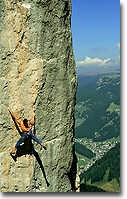Manfred Stuffer

 1 / 4
1 / 4 Manfred Stuffer archive
Manfred Stuffer archive
Ortisei, Val Gardena, South Tyrol, Italy
In this picturesque little town in the heart of the Dolomites the mountain
guides have decided to stage their first climbing competition. The anxious
crowd, packed tightly into the main square, watches excitedly as one
climber after the next drops off the overhanging wall until, finally, the
"local hero" steps out of isolation. The loudspeaker booms and a great
cheer of appreciation follows. Acknowledging the applause, the 24 year old
ties his knot and, showing little signs of pressure, calmly sets off up
the semi-final. Too calmly though, for this 8a+ is packed into 10 vicious
meters and requires explosive power, not unending stamina. The outcome is
painfully predictable and he too, like the others before him, ends up
dangling from the rope, far too soon. He waves briefly, hiding his
disappointment, slips into the crowd and disappears.
Just a few days later though, alone beneath the massive Sella group, he
makes the first ascent of Trick & Track, adding the mythical 8c grade
to the Dolomites. The record has been put straight, his expectations
satisfied. This is typical of this quiet, unassuming young South Tyrolean.
Called Manfred Stuffer.
Hard routes are what Manfred specialises in, and his list of repeated
routes in Italy, Austria, Spain, France and Australia is truly impressive.
The highlight so far has been the 3rd ascent of Alexander Huber's Gambit
8c+ in August 1995. But performances like these don't just come from
nowhere. Who is Manfred, and why have we heard so little of him?
Born in Ortisei beneath the towering Sasso Lungo, the imposing Sella
group, and the sharp Geisler Spitzen, it is easy to see why Manfred was
drawn to climbing at an early age. He served his apprenticeship in these
mountains, repeating many of the classic traditional routes, but soon the
focus shifted to smooth, steep walls where the grade, not the summit, is
what counts. Naturally gifted, his rise to the top was rapid but, unlike
some of his contemporaries, almost unnoticed. Until his repeat of Gambit
in August 1996. Then the climbing press woke up and took note.
Manfred's strength lies not so much in his raw power, but in his
never-ending stamina. He puts this down to his training regime, which
incorporates the crag as an effective training tool. Anyone who has
watched him workout at the crag will testify to this, as one 8a+ after the
next is displaced with in rapid succession, all day long, seemingly
without effort. He is often to be found at his favourite training ground,
just a few miles from home and beneath the Sella. Here all routes have
been drilled, chipped and consolidated with Sika, for the rock is
extremely friable. The result, a magnificently steep "playground" for the
elite, is no doubt highly debatable. Manfred comments coolly "if I climb a
great route which, with a considerable effort has been cleaned, chipped or
drilled, then I don't really care whether the holds are rock, sika,
plastic or even wood. The important thing is only that they don't hurt and
that the route is good fun to climb." Aware of the fact that his opinion
may differ sharply from many climbers he adds "ethically speaking it would
of course be better to refrain from such actions, but I nevertheless
believe we must respect the view of the first-ascentionist. I appreciate
Rheinhold Scherer's "Pietra Murata" (created after many, many hours of
drilling and gluing) just as much as Alexander Huber's "Gambit" (created
after many, many hours of searching and cleaning). Different crags
obviously offer different opportunities and it's up to us to use these
sensibly."
It soon becomes clear that there is more to Manfred than climbing,
that he is not just interested in redpointing one hard route after the
next. One is immediately struck not just by his massive build, but also by
his welcoming friendliness, a trait which has earned him great respect
from the climbing world. There is no hint of arrogance or elitism, all to
often residual within the protagonists of this sport, as he dicusses
issues with others, regardless of the grades they climb. At the cutting
edge of any sport, sadly this is not often the case.
Everyone knows that there is little room at the top, and Manfred is only
too aware of this. "Those who try to climb for a living, usually end up
poorer than before" he explains, pointing to his decision to study sports
psychology at Innsbruck University, and his desire to become a Mountain
Guide. Collaborating closely with Boreal and Mammut has given him more
financial freedom, but he seems in no rush to finish his studies, instead
taking full advantage of his student life. "Like my past, I'll go where
the flow takes me" he adds, inducing us to believe that all is left up to
chance, to improvisation. But this is highly unlikely, for I believe his
life to be a reflection of his climbing, where nothing is left up to
chance. This statement masks the fact that there's a determined, clear
thinking man at the tiller. Who just happens to be extremely strong as
well.



 Copia link
Copia link






















